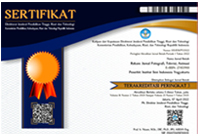Analisis Aisas Model Terhadap Product Placement dalam Film Indonesia Studi Kasus: Brand Kuliner di Film Ada Apa Dengan Cinta 2
Abstract
Penelitian ini bertujuan untuk menganalisis AISAS Model atas product placement dari brand
(tempat) kuliner pada film Ada Apa Dengan Cinta (AADC) 2. Film ini menjadi objek penelitian
karena tingginya minat menonton dari masyarakat hingga membuatnya menjadi salah satu
film terlaris di Indonesia pada tahun 2016. Penelitian ini mengambil dua teori utama dalam
bidang komunikasi pemasaran, yaitu teori AISAS dan product placement. Jenis penelitian ini
adalah kualitatif deskriptif, dengan teknik observasi dan wawancara mendalam kepada 12
orang informan yang telah menonton film tersebut minimal 1 kali dan berdomisili di Jakarta
Timur. Hasil dalam penelitian ini menyebutkan bahwa berdasarkan analisis AISAS, product
placement atas brand (tempat) kuliner dalam film membantu promosi brand kuliner tersebut.
Poin Search, Action, dan Share memberikan peluang besar dan sangat baik dalam keberhasilan
promosi sehingga konsumen dapat dekat, mengalami, dan merasakan brand.
The Analysis of AISAS Model towards Product Placement of Indonesia Movie: A Case
Study on the Culinary Brand of Ada Apa Dengan Cinta 2 Movie. This study aims to analyze
AISAS Model on product placement of culinary brand on Ada Apa Dengan Cinta (AADCWhat’s
up with Cinta) 2 movie. The movie becomes the object of research because of the high
interest from the public to watch, making it one of the best-selling movies in 2016 in Indonesia.
This study takes two main theories in the field of marketing communications, namely AISAS
and product placement. The research is a qualitative descriptive by observation and in-depthinterview
technique to 12 informants staying in East Jakarta who have seen the film at least
once. The result of study mentions that based on the AISAS analysis, product placement of
culinary brand (places) on the film helped the promotion of the culinary brands. Some points
such as Search, Action, and Share provide great opportunities to the success of the campaign
so consumers can be close, experience and feel the brand.
Keywords
Full Text:
PDFReferences
Balakhrisnan B. KPD., Azlinda Shazneem Md.
Shuaib, Oscar Dousin, P. Yukthamarani
Permarupan. 2012. “The Impact of Brand
Placement and Brand Recall in Movies:
Empirical Evidence from Malaysia”.
International Journal of Management and
Marketing Research. Vol. 5, No. 2, p. 39.
Hackley, Chris. 2005. Advertising and
Promotion: Communicating Brands.
London: Sage Publications.
Kaur, B. 2014. “Product Placement in Movies:
The Bollywood Experience”. Global
Journal of Finance and Management. Vol.
, No. 1, p. 55.
Kazutoshi, M. 2006. “Changes in Services by
Communications-Broadcast Convergence
Solutions”. NEC Technical Journal. Vol. 1,
No. 2, p. 138-139.
Kit, LC., Elizabeth Lim Qui P’ng. 2014”. The
Effectiveness of Product Placement: The
Influence of Product Placement towards
Consumer Behavior of the Millennial
Generation”. International Journal of
Social Science and Humanity. Vol. 4. No.
, p. 138.
Kaijansinkko, Riku. 2003. “Product Placement
in Integrated Marketing Communications
Strategy”. Tesis MA tidak diterbitkan.
Lappeenranta: Department of Business
Administration.
Pateman, T. 1983. “How is understanding an
advertisement possible?” dalam H. Davis
and P. Walton (Eds). Language, Image,
Media. Edisi Indonesia diterjemahkan oleh
Ikramullah Mahyuddin. 2010. Bahasa,
Citra, Media. Yogyakarta: Jalasutra. Hal.,
Schiller, H. 1985. “Electronic Information
Flows: New Basis for Global Domination?”
dalam Chris Barker. Cultural Studies. Edisi
Indonesia diterjemahkan oleh Nurhadi.
Cultural Studies: Teori dan Praktek.
Bantul: Kreasi Wacana. Hal., 299.
Sung, Yongjun, dan Gregorio, De Federico.
“New Brand Worlds: College
Student Consumer Attitudes toward Brand
Placement in Films, Television Shows,
Songs, and Video Games”. Journal of
Promotion Management, Vol. 14, No. 1, p.
-101.
Tang, R., Zhenji Zhang, Xiaolan Guan, Lida
Wang. 2014. “A Study of Short-term Effect
Measurement for Information Publication
in Government Microblog”. International
Journal of Hybrid Information Technology,
Vol. 7, No. 1, p. 58.
Waldt, DLR., LS Du Toit, R Redelinghuys.
“Does Branded Product Placement
in Film Enhance Realism and Product
Recognition by Consumers?” African
Journal and Business Management, p. 19-
Pustaka Laman
www.dentsu.com, diakses pada 20 September
, pukul 22.00 WIB.
DOI: https://doi.org/10.24821/rekam.v12i2.1424
Refbacks
- There are currently no refbacks.

This work is licensed under a Creative Commons Attribution 4.0 International License.



